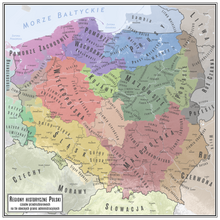|
Bielsk Land
 Bielsk Land, (Polish: ziemia bielska, named after the town of Bielsk Podlaski) was an administrative unit (ziemia) of the Grand Duchy of Lithuania, Kingdom of Poland and the Polish–Lithuanian Commonwealth. Created in 1413, it originally belonged to the Lithuanian Trakai Voivodeship. In 1513, it became part of newly created Podlasie Voivodeship, and from 1569 until 1795, it belonged to the Kingdom of Poland. Bielsk Land had its capital in Bielsk Podlaski, local sejmiks also took place in this town, with two envoys elected to the Sejm in Warsaw. Bielsk Podlaski however was not the largest town of the land, as it was smaller than Bransk, Tykocin and Goniadz. The Land of Bielsk was created after a merger of territories of three smaller entities:
Altogether, Bielsk Land was the largest of the three lands of Podlasie Voivodeship - it made its northern half, with such towns, as Bielsk, Bransk, Tykocin, Goniadz, Kleszczele, Bialystok, Knyszyn, Choroszcz, Rajgrod, Narew, Augustowo, Orla, Bocki and Jasionowka. Bielsk Land had two starostas - those of Knyszyn and Tykocin. Sources
|